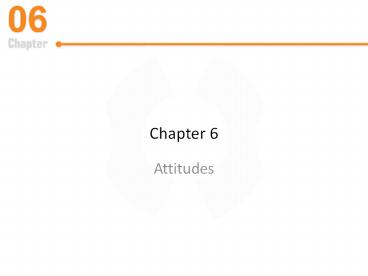Attitudes - PowerPoint PPT Presentation
Title:
Attitudes
Description:
Chapter 6 Attitudes – PowerPoint PPT presentation
Number of Views:309
Avg rating:3.0/5.0
Title: Attitudes
1
Chapter 6
- Attitudes
2
What is an Attitude?
- A positive, negative, or mixed reaction to a
person, object, or idea expressed at some level
of intensity.
3
How Attitudes Are Measured Self-Report Measures
- Self-report measures are direct and
straightforward, but sometimes attitudes are too
complex for a single question. - Attitude Scale A multiple-item questionnaire
designed to measure a persons attitude toward
some object. - e.g., Likert Scale
- Bogus Pipeline A phony lie-detector device that
is sometimes used to get respondents to give
truthful answers to sensitive questions.
4
How Attitudes Are Measured Covert Measures
- Observable behavior
- Facial Electromyograph (EMG) An electronic
instrument that records facial muscle activity
associated with emotions and attitudes. - Neuroscience research ongoing
- Appears attitudes may be measurable by electrical
brain activity
5
How Attitudes are Formed
- Our most cherished attitudes most often form due
to exposure to - Attitude objects
- History of rewards and punishments
- Attitudes of family, friends, enemies, etc.
- Social and cultural context
- Personal experiences
- Clearly, attitudes are formed through basic
processes of learning but how much do they
influence behavior?
6
Attitudes in Context
- Theory of planned behavior attitudes toward a
specific behavior combine with subjective norms
and perceived control to influence a persons
actions
7
Strength of the Attitude
- Why do some attitudes have more influence on
behavior? - Depends on attitudes importance or strength
- Why are some attitudes stronger than others?
- Because of our genetic make-up?
- Does it directly affect ones own outcomes and
self-interests? - Is it related to deeply held philosophical,
political, and religious values? - Is it of concern to ones close friends, family,
and social ingroups?
8
Factors That Indicatethe Strength of an Attitude
- The more well informed on a topic, the more
consistent behavior is with attitude - Not only amount of information, but also how that
information was acquired - An attitude can be strengthened by an attack
against it from a persuasive message - Strong attitudes are highly accessible to
awareness, how quickly and easily they are
brought to mind.
9
Two Routes to Persuasion
- Central Route Person thinks carefully about a
message. - Influenced by the strength and quality of the
message - Peripheral Route Person does not think
critically about the contents of a message. - Influenced by superficial cues
10
The Central Route (contd)
- Assumption that the recipients are attentive,
active, critical, and thoughtful. - Assumption is correct only some of the time.
- When it is correct, the persuasiveness of the
message depends on the strength of the messages
content. - The central route is a thoughtful process.
- But not necessarily an objective one
11
The Peripheral Route
- People are persuaded on the basis of superficial,
peripheral cues. - Message is evaluated through the use of
simple-minded heuristics. - People are also influenced by attitude-irrelevant
factors.
12
What Makes an Effective Source?
- Believable sources must be credible sources.
- To be seen as credible, the source must have two
distinct characteristics - Competence or expertise
- Trustworthiness
- How likable is the communicator?
- Two factors influence a sources likability
- The similarity between the source and the
audience - The physical attractiveness of the source
13
Is the Source MoreImportant Than the Message?
- It depends
- How personally relevant is the message for the
recipient?
14
What Makes an Effective Message?
- How should the argument be presented to maximize
its strength? - Are longer messages better?
- If peripheral, the longer the message, the more
valid it must be. - If central, message length is a two-edged sword.
- Does presentation order matter?
15
Subliminal Influence
16
Regulatory Fit
- To what extent does the message meet the
psychological needs of the audience? - Does the message fit the frame of mind of the
audience and feel right? - Promotion-oriented vs. prevention-oriented
17
Forewarning and Resistance
- Advanced knowledge allows time to develop
counterarguments. - Inoculation hypothesis
- Being forewarned elicits a motivational reaction.
- Psychological reactance
- Effects of forewarning depends on personal
importance of message.
18
Cognitive DissonanceTheory The Classic Version
- We are motivated by a desire for cognitive
consistency. - Cognitive Dissonance Theory Inconsistent
cognitions arouse psychological tension that
people become motivated to reduce. - Can lead to irrational and sometimes maladaptive
behavior
19
Alternative Routes to Self-Persuasion
- Self-Perception Theory Self-persuasion through
observation of own behavior. - Impression Management Theory What matters is not
a motive to be consistent but rather a motive to
appear consistent. - Self-Affirmation Theory Dissonance situations
create a threat to the self.































